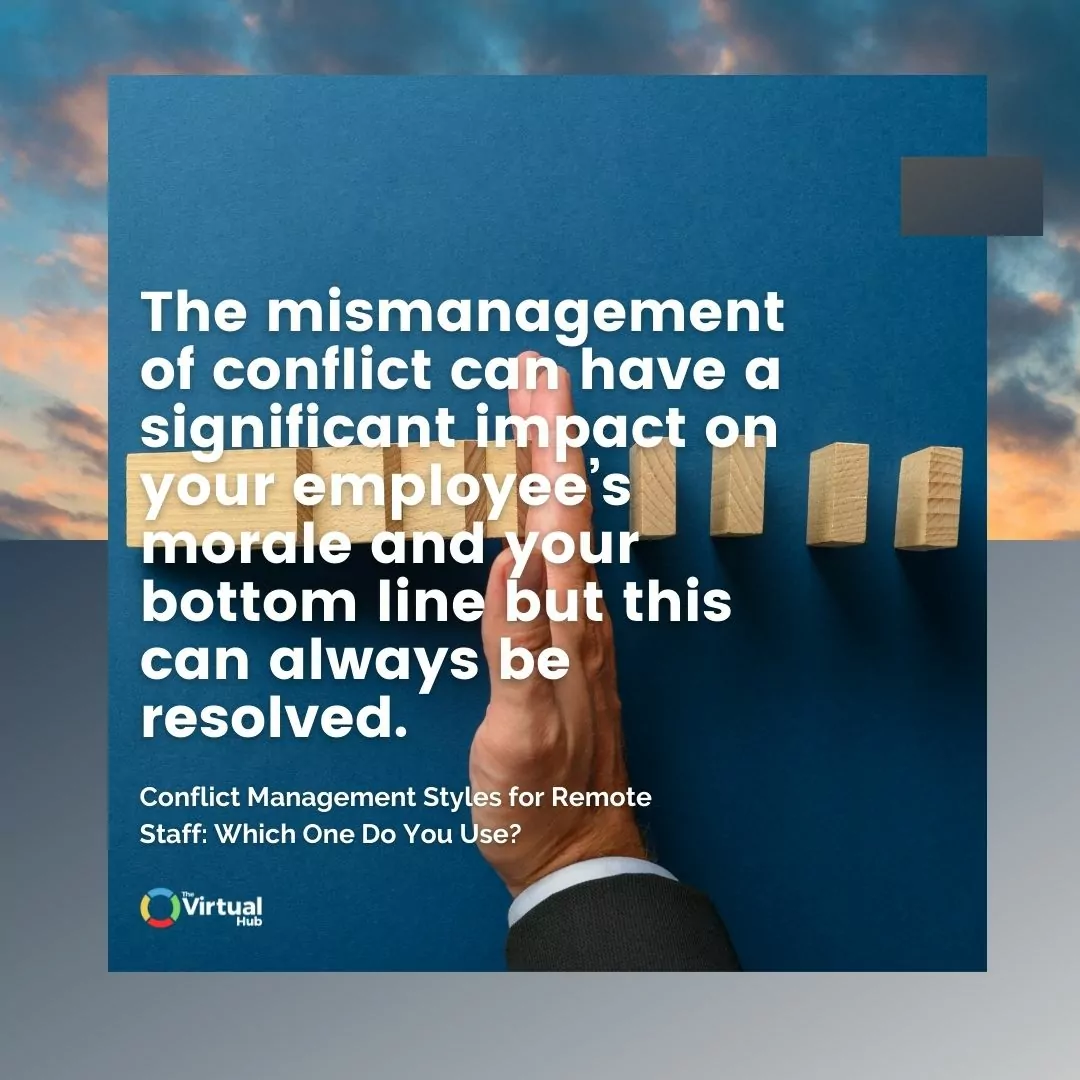Conflict management styles are important to have in your back pocket when working with remote staff. But which style do you use? And how can you make sure that everyone's on the same page when it comes to conflict resolution?
Check out this blog post for tips on how to handle conflict management in a virtual and hybrid workplace.
RELATED: The Four Decision Making Styles: Which One's Your Style?
How to Handle, Settle, and Prevent Workplace Conflicts in Remote and Hybrid Teams
You can click on these links below to jump on a specific reason:
- What Is Conflict Management?
- Who Is Involved in Conflict Management?
- Why Is Conflict Management Important?
- What Are the Different Conflict Management Styles?
- How Is Conflict Management Different with a Remote Worker?
- Which Conflict Management Style Should You Use for Your Remote Staff?
- What Is the Relationship between Leadership Styles and Conflict Management Styles?
- How Do You Prevent Conflict in the Remote Workplace?
What Is Conflict Management?
Before we dive into conflict management, it’s important to understand first the nature of conflict in the workplace.
Conflict occurs when there’s disagreement between two or more parties. It can be about different personalities, ideas, or values.
In most workplaces, there are six common sources of conflict:
- task-related issues
- differences in ideas/strategies
- work style differences
- clashes in leadership styles
- personality conflicts
- harassment or discrimination

However, while conflict is a natural part of working together, it doesn’t always have to be a bad thing!
In fact, conflict can actually be healthy for virtual teams. It can lead to new ideas and ways of thinking. But if not managed properly, conflict can quickly escalate and become destructive.
That’s where conflict management comes in.
Conflict management is the process of resolving and handling disagreements between parties. It includes both the proactive measures you take to prevent future conflicts from happening in the first place, as well as the reactive measures you take to resolve them when they do arise.
Conflict management is effective when managers can:
- prioritize positive outcomes
- minimize negative consequences
In many scenarios, mediators try to look for the middle ground so they can propose a win-win solution.



Who Is Involved in Conflict Management?
he conflict management process should only involve the concerned parties and the mediator. This may involve individual employees or key team members.
Managers, bosses, or even virtual leaders can serve as the mediator. It’s important for mediators to be impartial and fair. They need to possess important mediation and people skills such as:
- empathy
- active listening
- questioning skills
- summarizing skills
- critical thinking skills
Why Is Conflict Management Important?



The mismanagement of internal conflict can hurt businesses. Here are some outcomes linked to poor conflict management:
- poorer job performance
- lower employee job satisfaction
- increase in absences
- higher turnover
- legal issues
On the flip side, here are some benefits of effective conflict management:
- reduces uncertainty and promotes clarity
- encourages tolerance and empathy
- clarifies training needs
- creates stronger bonds between co-workers
Small business or start-up owners need to maximize their resources and avoid the expense associated with these outcomes.



What Are the Different Conflict Management Styles?
One size doesn’t fit all when it comes to conflict resolution. Each workplace and situation is different, so managers need to figure out which strategies are most appropriate for the issue at hand and for the team member involved.
However, research shows that conflict management strategies generally fall under five conflict management styles:
Accommodating Style
When leaders use this style, they try to put the needs of other parties before their own. It’s usually used when issues are minor or when they want to choose their battles. Although, when managers over-use this style, they may seem too easygoing and lose some of their authority.
Avoiding Style
This style aims to avoid the whole conflict management process by simply ignoring issues or removing the source of the conflict. The conflict is swept under the rug which can sometimes make things worse. It may be helpful if an employee can benefit from taking a break from certain projects or tasks.



Compromising Style
This style tries to find a middle ground that both parties can agree on. It may involve making small sacrifices from both sides. The goal is to move forward and get the job done. However, this style may not always be the most effective in promoting a healthy workplace environment.
Competing Style
This conflict management style relies on choosing the “right” decision. There's no give or take in this style. Managers take the lead and choose a specific course of action without much consultation.
If there are time constraints, this can help in solving problems quickly. However, it may lead to resentment if employees start to feel unvalued.
Collaborating Style
Compared to the other styles, this one is more time-consuming because it involves potentially lengthy negotiations and discussions. The goal of this style is to reach a mutually beneficial solution where both parties are satisfied.
Managers can use these five different styles to help them navigate through conflict situations. Some managers even use a combination of styles.
For example, in the interest of time, they may use the competing style to arrive at a temporary solution. If they sense that it’s a recurring problem, they may transition to the collaborating style to come up with a long-term solution.
These different strategies and styles of conflict management are common in most workplaces, but their applications may be different if you’re working with remote staff.



How Is Conflict Management Different with a Remote Worker?
Conflict management can be different with remote staff because the nature of their conflict is different. A remote and hybrid work environment face conflicts that may not be as common in regular work environments.
Here are some common conflicts that can arise among your remote staff:
Miscommunication
Tone doesn’t translate as well on emails or instant messaging (especially if you’re dealing with someone new). With body language and other nonverbal cues out of the picture, it can be difficult to read the situation accurately. Some people can come across as rude even if they don’t mean to be.
Lack of Information




Each communication channel has inherent limitations. So even if you’re constantly emailing and instant messaging, details can still fall through the cracks.
In a remote working environment, communicating takes more effort. You can’t just drop by someone’s office to informally clarify something.
Conflict Avoidance
It may require more effort to discuss issues and challenges in a remote working environment. It may not seem worth it to send an email about a minor issue. People don’t want to rock the boat. Unfortunately, minor issues can pile up.
Higher Levels of Uncertainty
When feedback isn’t provided on time, employees may feel insecure about their performance. And when instructions are unclear, they may feel lost and confused.
Cultural Differences
If you have a remote team that’s internationally distributed, cultural differences can lead to conflict. For example, what’s considered polite in one culture may be seen as impolite in another.
Different Working Style Preferences
Some people prefer to work independently while others like to collaborate. When team members have different working style preferences, it can lead to conflict.
Trust Issues
It can be difficult to build trust with a remote team. You can’t see what they’re doing and you can’t easily check in on them. This lack of transparency can lead to conflict.
Decrease in Inhibition
This can be a problem for remote workers who don’t see their coworkers regularly. The lack of real-time interaction can make them feel more anonymous and, therefore, bolder towards their co worker. If they can accomplish their tasks independently, group harmony isn’t prioritized as much.
Which Conflict Management Style Should You Use for Your Remote Staff?
Just like other workplaces, managers need to decide on the best conflict management style to use with each conflict. The accommodating, compromising, and collaboration styles can work well in a remote working environment.
Since remote working environments are already at risk for communication and information issues, try to steer clear of the avoiding style. It can foster more uncertainty amongst your remote employees which isn’t good for their morale.
RELATED: 10 Skills For Peaceful Conflict Resolution In The Workplace


What Is the Relationship between Leadership Styles and Conflict Management Styles?
Effective leadership styles can have a significant impact on the way conflicts are managed within an organization. The leadership style that’s adopted can either set the tone for healthy conflict management or contribute to a toxic environment.
The following are examples of how different leadership styles might influence conflict management:
Authoritarian Style
This leadership style is characterized by a leader who has complete control and makes all the business decisions. Under this type of leadership, employees are less likely to voice their opinions or challenge the status quo, so conflicts may not be surfaced and addressed.
Laissez-Faire Style
The laissez-fair leadership style is characterized by a hands-off approach. The leader provides little to no direction and leaves employees to fend for themselves. In this type of environment, employees may avoid conflict because they don’t want to rock the boat.
Democratic Style
This style is characterized by a leader who lets their employees to provide input and values employee involvement. In this type of environment, remote staff are more likely to feel comfortable surfacing conflicts.
Transformational Style
The transformational style is characterized by a leader who motivates and inspires employees to achieve business goals. Under this type of leadership, employees are more likely to see conflict as an opportunity for growth.
Servant Style
Servant leadership focuses on employee development and meeting their needs. In this type of environment, servant leaders work to build trust with their employees. As a result, employees feel comfortable coming to their leader with conflict.
Situational Style
Situational leaders adapt their style to the situation. In this type of environment, employees are more likely to feel comfortable surfacing conflicts because they know their leader will take the time to listen and address the issue.
Participative Style
Participative leadership seeks input from employees when making decisions. In this type of environment, participative leaders provide employees with a sense of ownership.
Remember that there's no single leadership style that's right for every organization. The best way to determine which style is right for your organization is to assess the needs of your employees and the culture of your organization.
How Do You Prevent Conflict in the Remote Workplace?
To prevent or reduce conflict in remote settings, you may use the following tips and strategies:
Communicate in a Clear and Timely Manner
Leaders need to model good communication to their employees. Communication from the leaders should always bring a sense of clarity. Remember, it’s usually better to err on the side of over-communication rather than under-communication. Thus, paying close attention to leadership executive search when looking for the next hires will be detrimental to your company.
Schedule Regular Team Meetings
It’s important to touch base with your team. Regular team meetings allow your staff to bring up issues they normally wouldn’t over email or instant messaging.
Additionally, make sure you allow some time for your team to ask you questions. Meetings are also a great opportunity to establish good rapport with your team.



Encourage Group Brainstorming Sessions
Group brainstorming sessions are a great way to get employees to share their ideas and work together to solve problems. These sessions also allow you to get a pulse on the team’s morale and how they’re working together.
However, brainstorming sessions can sometimes be frustrating if people are not respectful of each other's ideas. This is why it's important to set some ground rules and encourage mutual respect and open-mindedness.
Use Technology to Your Advantage
There are a number of tools available that can help you facilitate communication and collaboration in a remote environment. Some examples of these tools include:
- Slack
- Trello
- Asana
By using these collaboration tools, you can create a virtual space for your team to come together and work through conflicts.
Make Time for One-On-Ones
It’s important to schedule one-on-ones on top of your regular team meetings. One-on-ones allow your employees to bring up any concerns they have in a more private setting.
Managers can also use this time to give their employees regular feedback and see how they’re progressing on projects.
Encourage Your Employees to Socialize
In a remote working environment, it’s easy for employees to feel isolated. As a result, they may not form the same bonds as they would in a regular office setting.
One way to prevent this is by encouraging your employees to socialize with each other and do group activities. You can do this by having team lunches or happy hours over video chat.
Address Issues Right Away
Don’t let the elephant in the room linger. If you sense that there’s an issue arising, make sure you discuss it with the person involved. It’s easier to manage a conflict in its early stages.
Balance Out Your Feedback
Timely and constructive feedback can help prevent conflict, but try to balance out your feedback. It’s easy to feel demotivated and burnt out if you only receive negative feedback. So try to point out the positive and celebrate wins.
Ensure Quality Control
When working on projects remotely, it’s important to have quality control measures in place. This way, you can catch errors early on and prevent them from snowballing into bigger issues.
Set Guidelines
Many conflicts arise from uncertainty. You can eliminate a lot of this uncertainty if you have guidelines in place. Set clear expectations for your employees to help reduce ambiguity and prevent misunderstandings down the line.
Establish a Code of Conduct
A code of conduct lays out the expectations and rules for behavior within a company. This can help set the tone for how employees should interact with each other, especially in conflict situations.
Have a Virtual Open Door Policy
An open door policy is a great way to encourage transparency and two-way communication. In a remote working environment, you can have a virtual open door policy by setting office hours where your employees can reach out to you with any questions or concerns.
Final Thoughts
The mismanagement of conflict can have a significant impact on your employee’s morale and, ultimately, your bottom line. Challenges and disagreements are inevitable in any workplace, but the right conflict management strategy can help elevate your team to the next level.
Are you interested in building your remote team? Get in touch with us today to see how we can help you!
